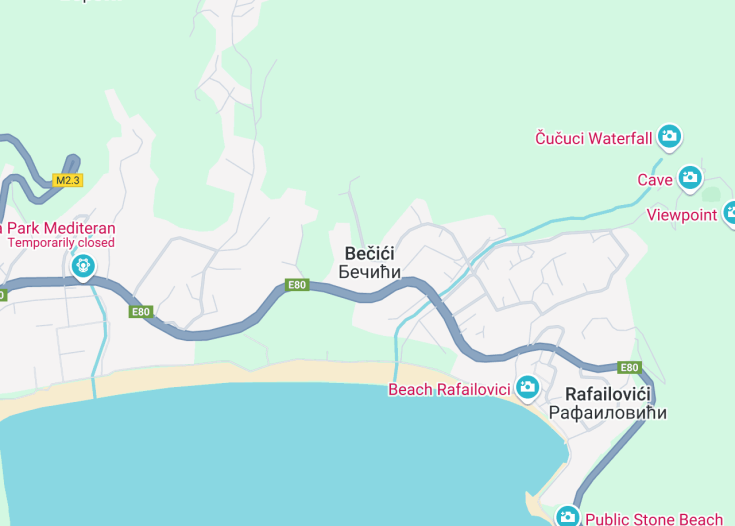Nestled on the picturesque Adriatic coast of Montenegro, Becici is a serene seaside town renowned for its stunning beach, a two-kilometer stretch of golden sand and clear waters. This idyllic destination is perfect for both relaxation and adventurous water sports.
Becici seamlessly blends natural beauty with luxurious resort comforts, making it a preferred spot for both families and solo travelers. The town is also a great base for exploring the historical riches and vibrant culture of the Montenegrin coast.
Plan your visit between late spring and early autumn to enjoy Becici at its best, with ideal weather for beach activities and local festivals.
Don’t miss a day trip to the nearby town of Budva, known for its medieval walls and lively nightlife, just a short drive from Becici.
Top things to do & see in Becici
Select the following sights and activities to discover best tickets and tours available in Becici.
Becici: A Mediterranean Gem
| Country | Montenegro |
| Time in Becici | GMT+1 |
| Language spoken | Montenegrin |
| Population | 771 (according to the latest data) |
| Currency | Euro (EUR €) |
| Airports |
|
Becici, located in Montenegro, is renowned for its striking blend of natural beauty and historical significance. This coastal town attracts tourists with its pristine sandy beaches and crystal-clear waters of the Adriatic Sea. Beyond the sun and sea, the area holds a rich history, evidenced by numerous old churches and monuments that dot the landscape.
Where is Becici?
Becici is situated on the Adriatic coastline of Montenegro, nestled between lush hills and the sparkling sea.
Distances:
| Route | Distance by car | Time by car |
|---|---|---|
| Podgorica to Becici | 40 miles | 1 hour 10 minutes |
| Tivat to Becici | 20 miles | 30 minutes |
What is Becici famous for?
Becici is especially famous for its spectacular beach, which has been awarded the Blue Flag status multiple times, symbolizing cleanliness and safety. It is also known for hosting high-profile conferences and other events.
History
Prehistoric to Medieval Times
The region around Bečići is steeped with a rich, albeit fragmented, historical tapestry. Evidence suggests that the area was inhabited since prehistoric times, primarily due to its favorable geographic position near the Adriatic Sea. The first recorded inhabitants were the Illyrians, a group of tribes known for their warrior culture, who lived throughout the Balkans. As the Romans conquered the region in the 2nd century BC, Bečići slowly integrated into the Roman province of Illyricum, which spread across the western Balkans.
Medieval to Early Modern Period (7th Century – 18th Century)
After the fall of the Roman Empire, Bečići found itself on the periphery of various empires, including the Byzantine Empire and, later, the Venetian Republic. The area was often contested by the rising powers of the medieval Serbian state, and it saw numerous changes in control. The Ottomans’ arrival in the 15th century marked another significant shift, introducing Islamic influences that mingled with the pre-existing Christian culture.
Modern Times (19th Century – Present)
In the 19th century, as the influence of the Ottoman Empire waned, Bečići experienced a resurgence as part of the Kingdom of Montenegro. The 20th century, particularly the periods during and between the World Wars, was marked by significant development in infrastructure and the beginning of tourism as a crucial sector for the area. After WWII, Bečići, as part of Yugoslavia, developed its facilities to cater to both domestic and international tourists, a trend that continued after Montenegro regained its independence in 2006. Today, Bečići is a modern touristic site, known for its beautiful beaches and luxury resorts, which blend with its deep historical roots to form its unique identity.
Visit Becici
What to see and do in Becici
Becici, nestled along the Montenegrin coast, offers an array of attractions and activities for everyone. One of the highlights is the stunning Becici Beach, recognized for its fine pebbly sands and crystal-clear waters, making it a paradise for sunbathers and water sports enthusiasts alike.
Explorers can venture to nearby historical sites like the town of Budva, which boasts ancient medieval walls and picturesque narrow streets. For nature lovers, a hike or a picnic at the slopes of the surrounding hills provide breathtaking views of the Adriatic. Don’t miss:
- Dukley Gardens Art Center
- Kamenovo Beach
- Sveti Stefan, an iconic islet and luxury hotel
Festivals and Events in Becici
Becici is not only about serene landscapes and historical sites but also plays host to vibrant events throughout the year. One of the most significant is the “Summer Fest,” which takes place throughout July and August, offering a range of musical, cultural, and food events that showcase local and international talent.
Additionally, the “Spring Theatre Festival” in May brings together performers and audiences for classic and contemporary theatre productions.
Best time to visit Becici
The ideal time to visit Becici is during the late spring to early autumn months, from May to September. During this period, the weather is most favorable, with warm sunny days that are perfect for beach activities and outdoor explorations.
The peak tourist season is in July and August, so visiting in the shoulder months, such as May, June, or September, can be advantageous for those looking to avoid larger crowds.
Is Becici worth visiting?
Undoubtedly, Becici is worth visiting. With its combination of stunning natural beauty, rich history, and modern tourist facilities, it offers a unique getaway suitable for all types of travelers.
Whether you’re looking for relaxation on pristine beaches, cultural enrichment through historical explorations, or active engagements through hikes and water sports, Becici provides a comprehensive and fulfilling holiday experience. Its accessibility and hospitality further enhance its appeal, making it a top destination in Montenegro.










